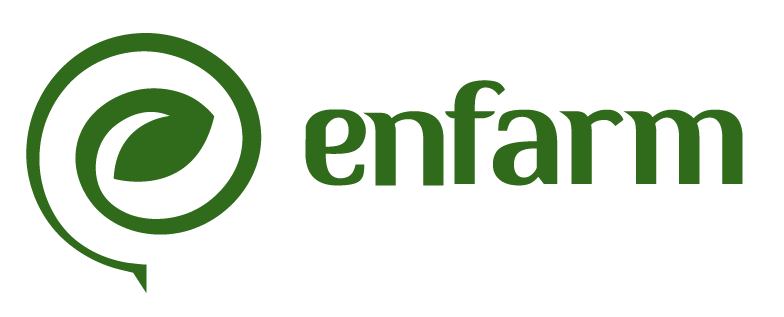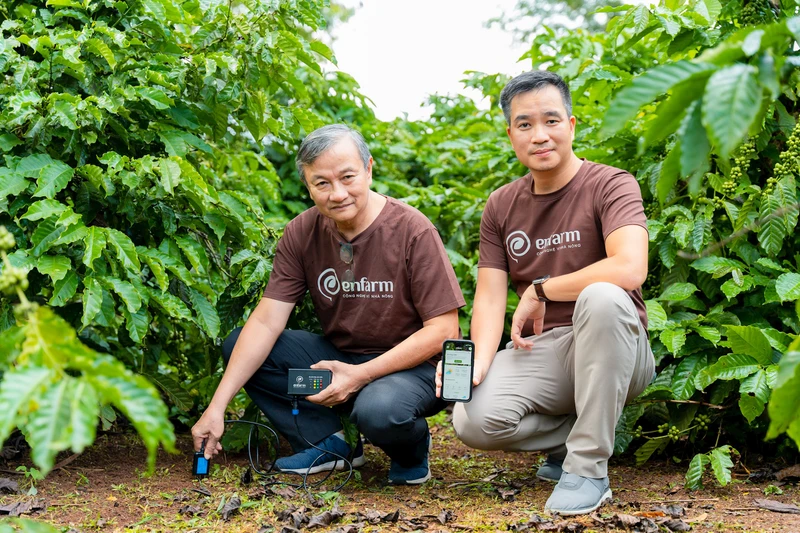Knowledge
Soil, sensors, and a smarter future
Co-founder Dzung Do Nguyen recently appeared on Quest Ventures’ “Questions With” podcast to discuss his entrepreneurial journey and the vision behind enfarm Agritech. The conversation started with how his background in urban planning and environmental modeling led to breakthrough innovations in precision agriculture.
Dzung Do Nguyen: When I was a child, two of my heroes were Thomas Edison and Benjamin Franklin. I admired them because they were inventors who, through their life’s work, innovated and created solutions that significantly improved people’s lives, not just in the U.S, but around the world. That was my dream.
Later, while studying at the Hanoi University of Sciences – High School for Gifted Students in Physics, I developed a keen interest in interdisciplinary study. I sought a discipline that could bridge science, the arts, and the social sciences, and planning was the perfect fit. Many people might think planning is just about designing buildings, like an architect’s job. But in the global context, planning is a highly multidisciplinary field. As a planner, I learned a wide range of things. I studied at a liberal arts college in Canada, where I explored urban-themed films and poetry, along with economics and transportation planning. Later, at Georgia Tech in the U.S., I learned how to perform environmental modeling and use remote sensing and satellite imagery to understand cities and find solutions for them.
It felt natural for someone like me—trained in science, the arts, and social fields—to pursue this path. I enjoy writing, conducting research, and working with technology. One of my passions, which also earned me a Fulbright scholarship to Georgia Tech, was my concern about climate change and flooding in Ho Chi Minh City. Because of this, I pursued two things: first, I studied hydrology and did extensive computer modeling. Second, I reached out to a top expert in this field, Dr. Ho Long Phi, who is now my partner at enfarm. He’s a hydrologist, an environmental modeling expert, and a soil scientist. What we built in enfarm builds on that understanding of environmental modeling, and now we incorporate AI and machine learning. This allows us to collect much more data and find new models to understand the environment, translating that information into something very useful for farmers.
What inspired your transition from urban planning to launching enfarm Agritech?
Dzung’s research on the relationship between urban form and hydrological performance of Saigon river catchment in an International Society of City and Regional Planners (Isocarp)’s publication.
enfarm didn’t emerge out of nowhere. I’ve always harbored a passion for and concern about climate change and environmental issues. My studies in environmental modeling, and my collaboration with Dr. Ho Long Phi, a leading soil scientist and expert in modeling, laid the foundation.
As a planner and policy advisor to many provinces in Vietnam, I worked with co-ops and spoke directly with farmers to understand their challenges. What I realized is that farming in Vietnam is a risky business, full of uncertainties. A farmer is essentially a business person who has to rent land, buy seeds, grow the crop, and bring it to market. They bear all the risks but lack the know-how or capital resources that companies have to deal with these risks. This is particularly evident in the Mekong Delta and Red River Delta, where many people are leaving farming for factory work. In a factory, you get a stable salary with fewer risks. Farmers often earn less and carry all the uncertainty.
Around 2022, we had already built a tech team in Ho Chi Minh City for smart city solutions. It seemed like a natural transition from urban planning into smart cities. But I realized that with the same know-how, we could create a new tool for farmers to help them overcome uncertainties in the marketplace and climate change. Dr. Phi is a great scientist. We spent a year and a half on R&D. Last year, we launched our high-tech, AI-powered smart soil sensing and monitoring devices. Farmers can now use their phones to understand their soil conditions, crop needs, market prices, and weather. Our AI algorithms provide recommendations. We’re building an assistant for every farmer, helping them navigate uncertainty with better data and decision-making.
Could you elaborate on enfarm’s core product and the journey to develop it?
Dzung introduces enfarm technologies during Shark Tank Season 7 show on Vietnam National Television
One of the world’s biggest problems in agriculture is fertilizer overuse. It may be shocking to know that 60% of applied fertilizer is not absorbed by plants. Currently, we don’t truly know what’s in the soil or precisely how much plants need. Farmers follow general formulas, but every farm is different. Different weather, climate conditions, farming practices, and fertilizer types mean every soil is unique.
This creates enormous waste. I estimate that each farming household in Vietnam loses one to two months of income annually due to fertilizer overuse. Moreover, these chemicals damage cropland, creating a vicious cycle where farmers need even more fertilizer the following year. Furthermore, fertilizer is a major source of greenhouse gas emissions, accounting for 5% globally.
The FAO projects that by 2050, food demand will increase by 70%. At the same time, we all have a commitment to drive our emissions to zero. How can we achieve that? Technology is the solution. We must have a tool for farmers that is affordable, accessible, and, most importantly, precise, so they can know what’s in the soil and apply just enough. That’s what we invented.
We combine soil sensors with extensive location-based information, which allows us to contextualize it to the specific farm. We know their behavior, the crop they grow, the fertilizer they use, the soil type, and the weather conditions. By doubling the amount of input into our algorithm, we can provide soil condition data that’s meaningful to farmers and as precise as a lab test. That’s the breakthrough.
We don’t just provide data. If I just provide farmers with data, it’s like getting a blood test—I won’t understand the results; I still need a doctor to explain my health. So, we are both a lab test and a doctor to every farm. With generative AI, we can read the data, interpret it for farmers, and tell them in their local language what to do. That’s the idea behind enfarm.
The agriculture industry in Vietnam is very fragmented. What was your go-to-market strategy and how did you convince farmers to adopt this technology?
Dzung with Mr Trieu Van Lam who adopts enfarm to practice regenerative farming in Daklak.
It’s a big concern for everyone. A veteran in this field once asked me why we were trying to sell a product to the lowest-income group in society, suggesting it didn’t make business sense. As tech entrepreneurs, we have to try many different things; we have to be creative, and there’s no textbook for this. No one has ever published a textbook on how to sell to farmers or how to popularize a product among farming communities.
I started with something most people would consider sensible: I tried to sell to enterprises and co-ops, but it didn’t work out. For enterprises, decisions take forever, and they might not trust you, thinking, “Hey, you’re an urban planner; how much do you know about agriculture?”. For co-ops in Vietnam, they don’t actually make procurement or financial decisions; the farmers themselves do. Co-ops primarily organize farmers to grow the same product to certain standardized quality levels, but how much is spent on a crop depends on each individual farmer. So, that approach didn’t work.
Then we started selling directly to farmers, which many believed was an almost impossible task. I would say we succeeded for two reasons:
First, targeting the right niche market: If you read any textbook on tech startups, they advise dominating a small niche market first rather than diving into a large ocean where you can easily get lost. We chose coffee, which is high-value and highly concentrated. 90% of coffee farms in Vietnam are concentrated in only four provinces in the Central Highlands. Coffee is a product we sell only to high-income countries. Many agricultural products from Vietnam target middle or low-income markets, but coffee is unique in that we aim for European, North American, and Japanese buyers. The top four buyers of Vietnamese coffee are Germany, Italy, Japan, and America.
Coffee farmers in Vietnam have good incomes and are well aware of high environmental standards. I was very impressed by them. Vietnam is only about one or two percent behind Brazil in terms of the total amount of coffee harvested considered sustainable. We have one-third of Brazil’s land area for coffee and just 50% of their production volume, yet we are matching them in terms of sustainability in cultivation. This indicates that our farmers are highly aware of environmental standards.
Second, the open-mindedness of coffee growers: Most coffee farmers in the Central Highlands are very hardworking and open-minded. This is special because most are immigrants, people who moved from northern and central Vietnam to the Central Highlands during the Kinh Te Moi (New Economy) period. The government of Vietnam historically tried to relocate people from densely populated regions like the Red River Delta and central Vietnam to the Central Highlands, where land is abundant and very fertile. These migrant people are determined, hardworking, and willing to change. So, we targeted them.
Later, we expanded to durian, which also yields the highest revenue per farmer and is very difficult to grow and highly sensitive to weather changes. This makes it a perfect product for enfarm because farmers need our tool.
For our online sales strategy: We run online ads. We don’t go down and talk to every farmer individually because the challenge of selling in rural areas is that farms are very spread out, and logistic costs would kill the business. Most of our customers today (80%) are farmers who order online, and then we simply ship the product to them. This saves us a lot of cost and allows us to reach the right customers.
Now that we have established a good name and many farmers have adopted our technologies, we are starting to sell to enterprises again, specifically to big corporations. We are also starting to expand to other markets, like the Philippines.
Are you still focusing only on the coffee market, or have you expanded to other markets?
Coffee and durian are still our biggest markets, especially durian. We are working on a few other crops, but many people are already buying our product to use for other crops. As a sensor, our device can measure nutrients in any soil; it’s just that the recommendation feature is currently only available for coffee and durian. Even without specific recommendations, the data is still very useful for them. So, many customers are actually growing something else. I hope this year I can add a few more crops to our recommendation list.
What are the biggest obstacles in balancing profit and impact, and how have you overcome them?
Enfarm’s first team members, Son Hoang, an agronomist, and Nhut Mai, an environmental engineer, after a day of field work to install enfarm first prototypes in the Central Highland of Vietnam. Deep engagement with farmers and farming reality have been enfarm’s priority from day one.
There have been two major obstacles:
First, understanding farmers: I constantly ask myself, “How well do I understand farmers?” I’m an urban planner who grew up in cities, and farming isn’t something I was born into. Every time I visit a farm or meet customers, I try to understand their mindset, practices, and how we can help them. Every Thursday, my management team and I dedicate time to calling farmers and listening to their feedback. This is our effort to truly understand the farmers we serve.
Second, predictability versus reality in agriculture: Industries typically make more money because they’re predictable. If you set up a factory, you’ll get a product regardless of weather conditions because it’s machine-driven, and machines are predictable. However, the environment and farmer behavior are much more unpredictable. This has been agriculture’s biggest challenge for years. Why aren’t our agricultural practices sustainable? Very simply, corporations and scientists need to formulate solutions for millions of farms. But every farm is different—different soil, weather, crops, and practices. Even adjacent farms aren’t the same. This is why 60% of applied fertilizer isn’t absorbed: we can’t generate a single formula for success in this field.
AI allows us to customize. We collect data from every individual farm to build our models, then customize solutions for them. AI is truly a great solution for the farming industry, especially in fragmented countries like Vietnam where farm sizes are small. In the U.S., the average farm size is 400 hectares; in Australia, it’s 4,000 hectares. In Vietnam, it’s just about one hectare. How do you write a formula for every small farm? AI is the solution. Of course, we can’t solely depend on AI; we have to collect and understand data from every farm, every soil, and every farmer.
What’s your perspective on doing well versus doing good in business?
Dzung introduces enfarm technology to Vietnam Prime Minister Pham Minh Chinh (middle) and Lao Prime Minister Sonexay Siphandone at the Partnership for Green Growth and Sustainable Development Goals (P4G) Summit in Hanoi. Source: Vnexpress
I think what they say is correct, and as a company, you need to sustain yourself. My two main takeaways are:
First, be creative and adaptive: We need to be very creative and question our business model every single day. I’ve had to try so many different things every week to see how we can scale up. You have to adapt very quickly, otherwise, you cannot survive. For example, durian, which is our biggest market now, saw its price slashed by two-thirds this year. Farmers are in significant trouble, and that, of course, affects us. Because of cadmium, a heavy metal that the Chinese importer found in durian. That has led to a 100% border checks, which created a huge problem for durian growers and businesses in Vietnam. We immediately launched a program to help farmers check cadmium in their soil and trees. We want to be successful, and to do that, we need to make our customers successful; that’s the only way. We are working very hard on that, and of course, we have to invest in it. But I believe that if I can solve a major problem for them, we build trust, and if I can help them regain the market, I also gain the market. We have to be successful together.
Second, trust is paramount: In our field, when you work with farmers, trust is number one. If you don’t have their trust, you cannot sell to them. They are quite sensitive; if they perceive you as untrustworthy, they react strongly. So, I would say that in this field, you must do good first. They must see you as a giver, not a taker. There’s no other way; it’s not even a choice.
Second, trust is paramount: In our field, when you work with farmers, trust is number one. If you don’t have their trust, you cannot sell to them. They are quite sensitive; if they perceive you as untrustworthy, they react strongly. So, I would say that in this field, you must do good first. They must see you as a giver, not a taker.


